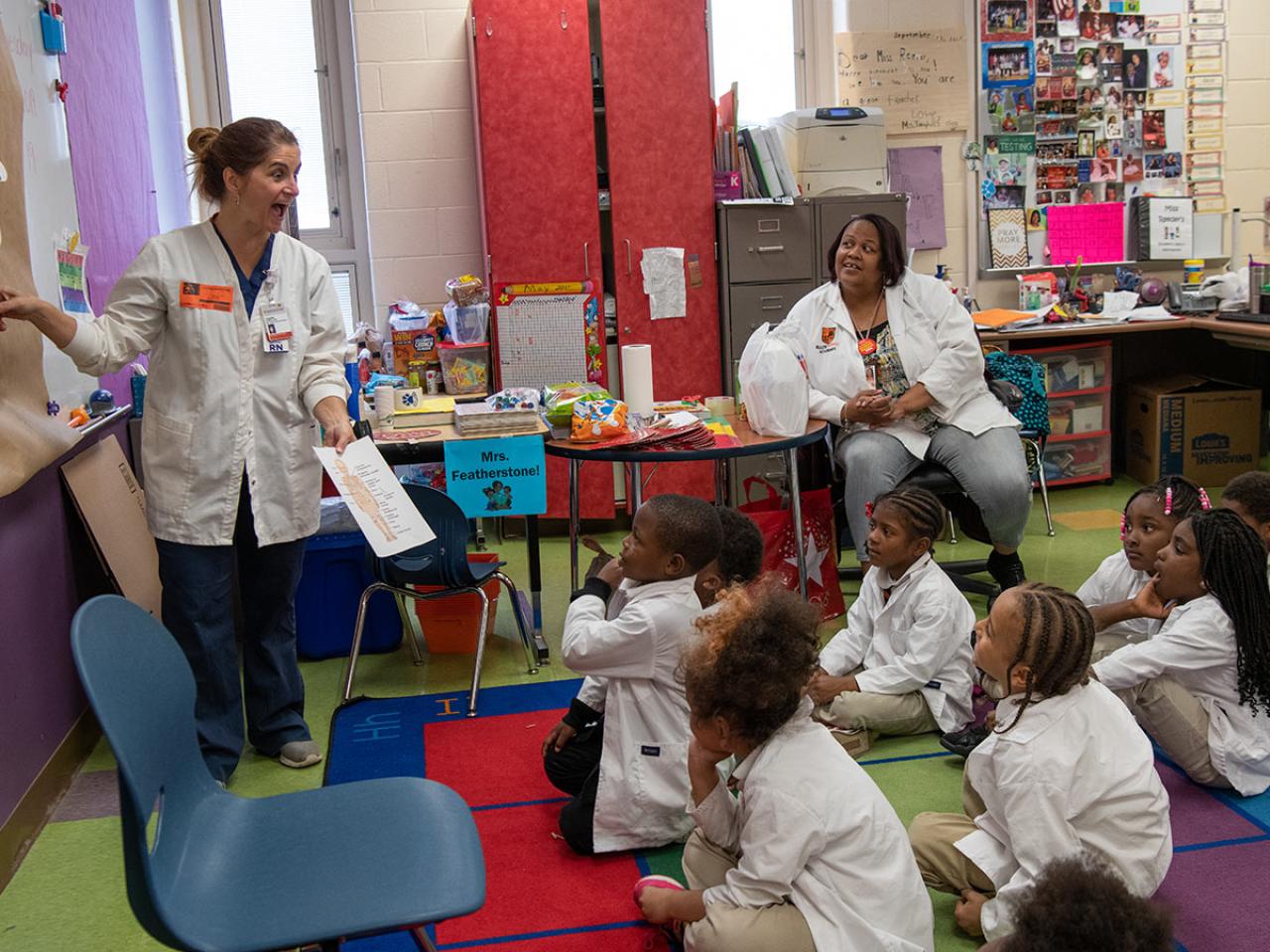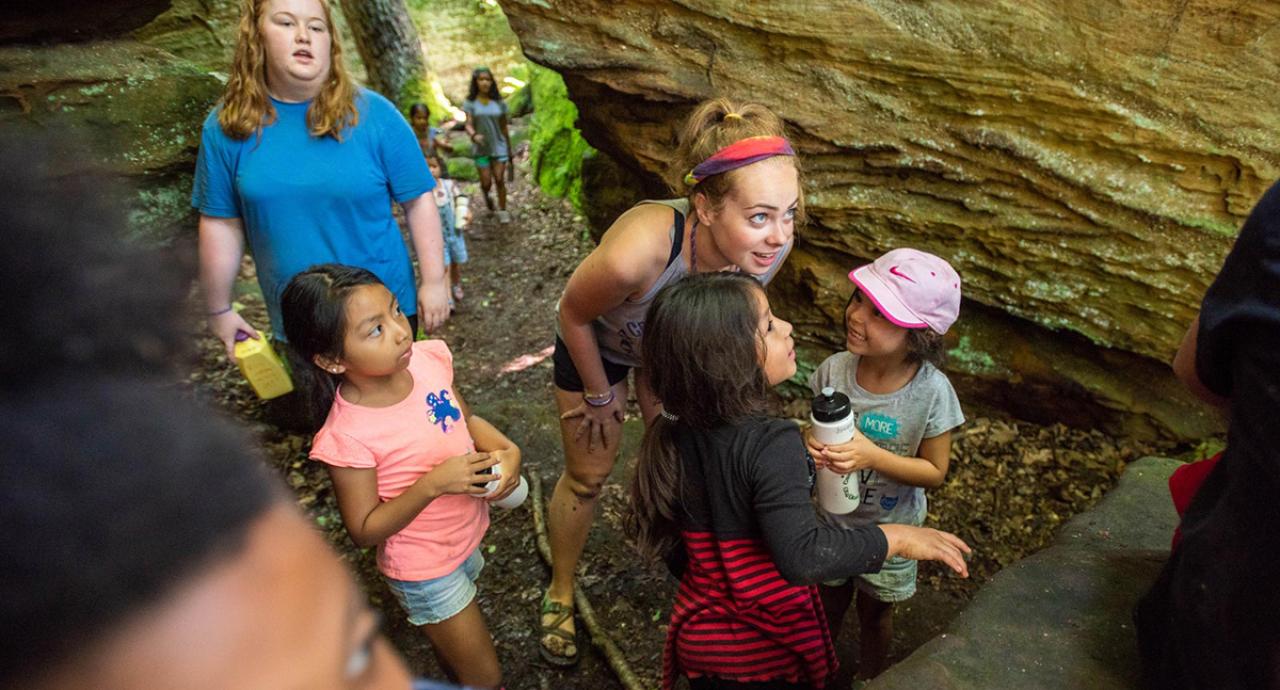
At Eastgate Elementary School, tiny lab coats hang from hooks, and experiments are underway.
Nurses from The Ohio State University Wexner Medical Center’s East Hospital are familiar faces in these classrooms, where they interact with wide-eyed students over today’s lesson.
At Champion Middle School, 23 eighth-graders board a bus bound for Ohio State’s academic medical campus. They spend the day in simulation labs, handle dissected pig hearts and learn from medical students who hail from their neighborhoods. The field trip ends with the teenagers closing their eyes, envisioning themselves here one day.
And at East High School, where those same eighth-graders will be next year, enrollment and graduation rates are on the rise, in part, because of the Health Sciences Academies.
A 10-year initiative between Ohio State and Columbus City Schools, the program rallies together the resources of a public research university, its health care system and a community’s determination to create promising futures for its children.
“When you bring a presence like Ohio State to an area that has been all but forgotten, people feel it, they see it,” said Tei Street ’89, who directs the Health Sciences Academies program for Ohio State.
Designing for rigor
The program began in 2015 at six schools on the Near East Side as part of Partners Achieving Community Transformation (PACT). The goal was to improve graduation rates at East High over 10 years.
“That’s a heavy lift,” Street said, “but if we never raise the bar, kids don’t know if they can jump.”
To increase rigor in the high school, educators needed to start in K-12 classrooms. And they needed support.
With the Health Sciences Academies, elementary students study a health sciences curriculum infused across math, language arts and other subjects. The “Adopt a Nurse” program and Career Fair Day bring Ohio State medical professionals into their learning environment in meaningful ways.
Meanwhile, the Parent University empowers parents to be better advocates for their children and gives them the tools they need to get more involved with academic life. Folks go home with a Parent Homework Dictionary, the book Coaching Your Child to Academic Success and a better understanding of how state report cards work.
As students advance to middle school and high school, they can choose to take specialized courses that could inspire and prepare them to work in health-related fields.
Administrators already see evidence of early success: Results from three years of the 10-year endeavor show three schools have jumped one to two levels on the state’s report card, and the graduation rate is up 8 percentage points at East High.
Also notable is that enrollment at East High has climbed 32 percent since the Health Sciences Academies were introduced.
“We will change the landscape of the schools in this area, and we will show what happens when everybody comes to the table for public education,” Street says. “We expect this to be an education destination.”

Exploring new possibilities
Schools on the Near East Side weren’t experiencing an achievement gap.
They were suffering from a belief gap.
“People not believing, not teaching children to believe in the greatness that is in them and their ability to academically perform,” Street said.
Having the courage to believe can be infectious, though. You invest your time, your microscopes, your lab coats and your dollars, and classrooms are transformed into laboratories. The learning experience intensifies for children, and a community wants to do more.
Belief moves the needles on a lot of gauges.
An opportunity came up to add a certification class to the curriculum at East High. And, because of the Health Sciences Academies, Street and school administrators had invested partners they could turn to for advice.
They met with human resources professionals at East Hospital to inquire what jobs would pay well and have higher demand in the marketplace. Sterilization of medical equipment is a specialized skill, and those positions can pay close to $15 an hour.
Not every student is destined for college, and Street said they wanted to create an option for East High graduates to enter the workforce and earn a living wage.
“How do we break that cycle of getting our families out of survival mode to where they are thriving?” she said. “You’re creating a pathway for these kids and families so that they can stay in this community. Because we know when education improves, families improve.”

Elementary school students in the Health Sciences Academies study a science-intensive curriculum that is infused across math, language arts and other subjects.
Photo by Jo McCulty
Impact in action
Three schools have jumped one to two levels on the state’s report card, and the graduation rate is up 8 percentage points at East High.
"We will change the landscape of the schools in this area, and we will show what happens when everybody comes to the table for public education. We expect this to be an education destination."
Tei Street ’89
Health Sciences Academies program director
Help kids become future lifesavers

Be a champion for communities.
When you invest in people, you invest in the belief that together, we can change lives and move communities forward.


